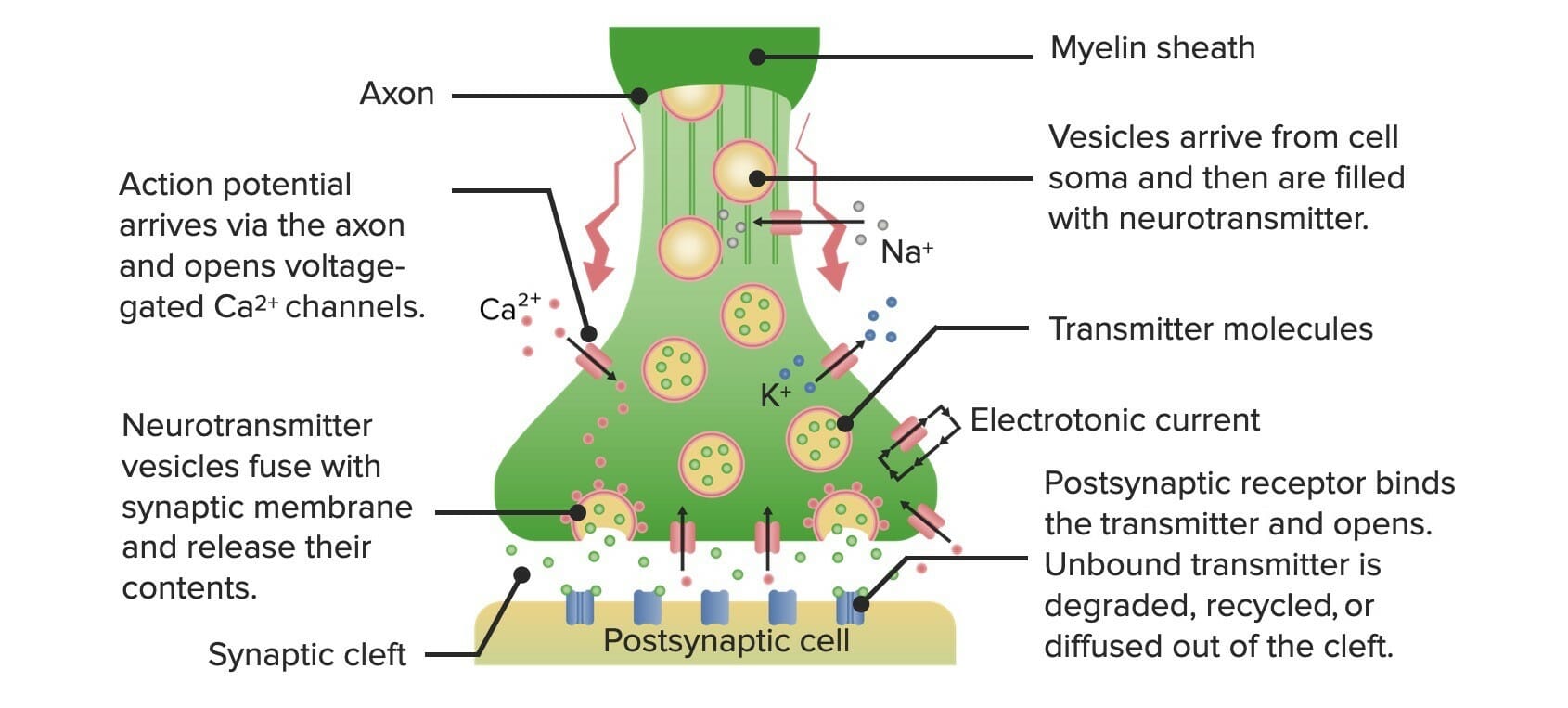Playlist
Show Playlist
Hide Playlist
Nerves and Neurotransmission
-
Slides 01 NervesNeurotransmission NervousSystem.pdf
-
Download Lecture Overview
00:01 Nerves, Neuroglia and Neurotransmission Nerves and various neuro communication networks are so important with our ability to communicate within the body. 00:14 The brain has to be able to control the various limbs to undergo movement. 00:19 Has to be able to control things like organs, so you get blood flow and so you get digestion to occur and how you do that is all via nerves. 00:29 Any individual nerve has a number of structural components. 00:33 And I know this is not an anatomy class, we’re gonna go through a couple of those now because we need to use them in physiology to better understand how this communication works. 00:44 So if we start off with the soma or cell body, this is where, we’re going to have the nerve packets of neurotransmitters are going to be produced. 00:55 You noticed there are some small dendrites usually around the nerve body or the soma? These can be part of the communication network to be able to receive signals. 01:06 Then you notice that we go down to the axon. And there’s a specialized region of the axon known as the axon hillock. 01:14 Here we then have some glial cells that are wrap in around our axon. 01:19 You’ll see these various Nodes of Ranvier. And finally we get to the synapses themselves. 01:26 And these are little terminal buttons sometimes called boutons. 01:33 If we go all the way to those axon terminals to start off our process. 01:38 Because this is where communication is actually happening. 01:42 You need to electrically provide information down the axon but once we get to the axon terminal, we still need to communicate pass the synapse. 01:52 You noticed there’s a little gap there. 01:55 We can’t pass electricity across that gap. 01:58 We are going to have to put a substance out into the synaptic cleft. 02:02 have a diffuse across and bind to the post synaptic receptor. 02:07 How do we get the neurotransmitter to be released? First, we need to get the neurotransmitter to the axon terminal. 02:15 Those are transported down the axon cause usually there’s not the production capacity in these axon terminals. 02:23 So those are travelling down as vesicles. 02:26 The vesicles then are store within the axon terminal. 02:31 Here we need to now have some way to activate them. 02:35 To get them to want to go to the synaptic cleft that dump out their substance. 02:40 The signal is electrical. 02:43 It is an electrical signal that’s coming down the axon which then stimulates voltage-gated calcium channels. 02:51 These voltage-gated calcium channels allow calcium influx into the axon terminal. 02:57 Why does calcium want to travel into the cell? Because of the concentration gradients. 03:03 So there is more calcium on the outside the cell then inside the cell, and that allows this concentration gradient to work. 03:11 Once calcium is in the axon terminal, it causes a reaction with the vesicle to want to migrate towards the synaptic cleft dock, infuse and spill its quanta of neurotransmitter into the synaptic cleft. 03:30 It then diffuses across to a postsynaptic receptor, and binds that receptor, and has an action. 03:38 usually in some sort of allowing for ions to travel through or maybe causing a cascade response within that postsynaptic cell. 03:47 So this whole process is done simply to get across that little gap that we can’t pass electricity acrossed. 03:55 The quanta of neurotransmitter that’s released can be classified into a number of different classification schemes. 04:05 Small molecules such as amino acids and good examples of these would be glutamate, GABA, glycine, all fit in these amino acid classification. 04:16 Cholinergic classification that’s acetylcholine. 04:20 Catecholamines are things like dopamine, norepinephrine and epinephrine. 04:25 And finally, our monoamines are things like serotonin and histamine. 04:30 Those are small molecule classification for our neurotransmitters. 04:35 But we also have some peptide. 04:37 Peptide transporters are things like opioids. 04:41 We also have other ones that serve various functions such as in the enteric nervous system. 04:48 So these peptide or neurotransmitters are important in the process of giving the information across. 04:55 We may not use them quite as much as we do some of those small molecule ones. 04:59 But they’re very important in specific areas of the body.
About the Lecture
The lecture Nerves and Neurotransmission by Thad Wilson, PhD is from the course Neurophysiology.
Included Quiz Questions
Which ion causes neurotransmitter vesicles to fuse into the pre-synaptic membrane?
- Calcium
- Sodium
- Potassium
- Magnesium
Where are neurotransmitter packets produced?
- Soma
- Synapses
- Dendrites
- Axons
- Nodes of Ranvier
Which of the following is a cholinergic neurotransmitter?
- Acetylcholine
- Glutamate
- GABA
- Dopamine
- Norepinephrine
Customer reviews
4,2 of 5 stars
| 5 Stars |
|
4 |
| 4 Stars |
|
0 |
| 3 Stars |
|
0 |
| 2 Stars |
|
0 |
| 1 Star |
|
1 |
Clear and simple. Explained in good sequence. Thank very You.
Muy bueno, pausado. Buen resumen, ademas evaluación continua del aprendizaje.
Thank you, dr. Wilson! Your lecture here is very much appreciated. You made it clear the important facts and process of synapses and neurons.
Errmmm I like his beard. It is very hairy, like me!






